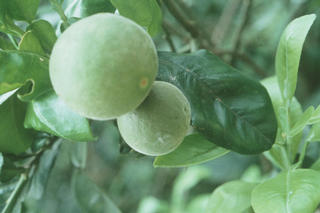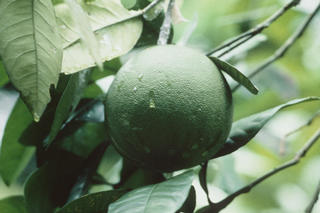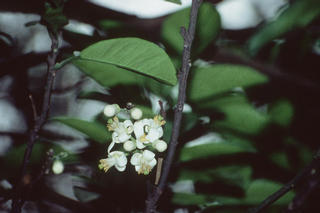Citrus grandis
Contents
Nomenclature
Other Names:
Historical Use of Citrus grandis
Citrus grandis in Traditional Chinese Medicine
Background
Chinese Name (pinyin): Huajuhong
Chinese Name :
Common Name :Pummelo peel
Specific Name : Exocarpium citri grandis
Scientific Name:
Collection : The drug is collected in summer when the fruit is unripe, treated with boiling water for a moment and the exocarp is cut into 5 or seven valves. Removed from the emergence and parts of mesocarp, compressed to a difinite shape and dried.
Description : Exocarp of Citrus grandis "Tomentosa": Opposite foldly septangular shape or spreadly star shaped the single piece willow-leaf-shaped. When whole, 15-28cm in diameter when spread, 2-5mm thick. Outer surface yellowish green, densely pubescent with wrinkles and small oil cavities, inner surface yellowish white or pale yellowish brown with veins striations. Texture frafgile, easily broken, fracture uneven with one row of uneven and sunken oil cavities in the outer border, the inner part slightly soft and elastic. Odour aromatic, taste bitter and slightly pungent.Exocarp of Citrus grandis: Outer surface yellowish green to yellowish brown, glabrous.
Identification : 1.Powder dark green to brown. Parenchymatous cells of mesocarp irregular, walls unevenly thickened, some beaded or extremely thickened at corners. Epidermal cells of pericarp polygonal, subsquare or rectangular in surface view, anticlinal walls thickened. Stomata sunrounded, 18-31µm in diameter with 5-7 subsidiary cells covered with cuticle layer in lateral view. The outer radial walls thickened. Fracture of nonglandular hairs visible occasionally, cells of fragments up to over 10, about 33µm in diameter at the widest position, walls warty or outer walls smooth and inner walls rough, lumina containing pale yellow or brown granular masses. Prisms of calcium oxalate polyhedral, rhombic, rhomboid prismatic, rectangular or irregular, 1- 32µm in diameter, 5-40µm long, occurring in parenchymatous cells of mesocarp abundantly in rows. Vessels spiral or reticulated, stone cells and fibres visible occasionally.2.To 1g of the powder add 10ml of methanol, heat under reflux for 20 minutes, cool and filter. To 1ml of the filtrate add about 5mg of potassium tetrahydroborate mix well and add several drops of hydrochloric acid, a cherry red or purple colour is produced.3.Use the filtrate obtained from identification (2) as the test solution. Dissolve naringin CRS in methanol to produce a solution containing 0.4mh per ml as the reference solution. Carry out the method for thin layer chromatography (Appendix Vl B) using silica gel G as the coating substances and the upper layer of ethyl acetate-formic acid-water (10:2:3) as the mobile phase. Apply to the plate 10µl of each of the two solutions. After developing and removal of the plate, dry it in the air, spray with aluminum chloride TS and examine under ultra violet light (365nm). The fluorescent spots in the chromatogram obtained with the test solution correspond in position and colour to the spots in the chromatogram obtained with the reference solution.Assay: Carry out the method for high performance liquid chromatography (Appendix Vl D)Chromatographic system and system suitability: Use octadecylsilane bonded silica gel as the stationary phase and methanol-acid acetic water (35:4:61) as the mobile phase. The wavelength of the detector is 283nm. The number of theoretical plates for the column is not less than 1000 calculated with the reference to the peak of naringin.Preparation of reference solution: Weigh accurately 20mg of naringin CRS, dried to constant weight at 110ºC in a 100 volumetric flask, dilute with methanol to volume and mix well. Accurately measure 3ml in a 10ml volumetric flask. Dilute with methanol to volume and mix well (containing 60µg of naringin per ml).Preparation of test solution: Weigh accurately 1g of the coarse powder, perform a determination of water (Appendix lX H, method 2) in a soxhlet's extractor, add 80ml of petroleum ether (60-90ºC), heat under reflux on a water bath for 2-3 hours. Discard the petroleum ether extract and expel solvent remained in the residue, add 80ml of methanol, further heat under reflux on a water bath for 3 hours until the extract is colorless, cool and filter. Transfer the filtrate to a 100ml volumetric flask, wash with container with a small quantity of methanol for several times, filter the washings to the same flask, dilute with methanol to volume. Measure accurately 5ml in a 25ml volumetric flask, dilute with methanol and mix well.Procedure: Inject accurately 5µl of the reference solution and 3-20µl (varying according to the concent) of the test solution into the column and calculate the content. It contains not less than 1.5% of naringin (C27H32O142H2O) on the dried basis.
Processing : Eliminate foreign matter, wash clean, soften thoroughly, cut into slivers or pieces and dry in the sun.
Action : To dispel cold, eliminate damp and phlegm, and arrest emesis or nausea.
Indication : cough, itching of the throat and profuse expectoration in colds; nausea, vomiting and epigastric distension caused by improper diet or excessive drinking
Precautions :
Dosage : 3 to 6 g.
Storage : Preserve in a cool and dry place, protected from moth.
Nomenclature
Other Names:
Historical Use of Citrus grandis
Citrus grandis in Traditional Chinese Medicine
Background
Chinese Name (pinyin): Huajuhong
Chinese Name :
Common Name :Pummelo peel
Specific Name : Exocarpium citri grandis
Scientific Name:
Collection : The drug is collected in summer when the fruit is unripe, treated with boiling water for a moment and the exocarp is cut into 5 or seven valves. Removed from the emergence and parts of mesocarp, compressed to a difinite shape and dried.
Description : Exocarp of Citrus grandis "Tomentosa": Opposite foldly septangular shape or spreadly star shaped the single piece willow-leaf-shaped. When whole, 15-28cm in diameter when spread, 2-5mm thick. Outer surface yellowish green, densely pubescent with wrinkles and small oil cavities, inner surface yellowish white or pale yellowish brown with veins striations. Texture frafgile, easily broken, fracture uneven with one row of uneven and sunken oil cavities in the outer border, the inner part slightly soft and elastic. Odour aromatic, taste bitter and slightly pungent.Exocarp of Citrus grandis: Outer surface yellowish green to yellowish brown, glabrous.
Identification : 1.Powder dark green to brown. Parenchymatous cells of mesocarp irregular, walls unevenly thickened, some beaded or extremely thickened at corners. Epidermal cells of pericarp polygonal, subsquare or rectangular in surface view, anticlinal walls thickened. Stomata sunrounded, 18-31µm in diameter with 5-7 subsidiary cells covered with cuticle layer in lateral view. The outer radial walls thickened. Fracture of nonglandular hairs visible occasionally, cells of fragments up to over 10, about 33µm in diameter at the widest position, walls warty or outer walls smooth and inner walls rough, lumina containing pale yellow or brown granular masses. Prisms of calcium oxalate polyhedral, rhombic, rhomboid prismatic, rectangular or irregular, 1- 32µm in diameter, 5-40µm long, occurring in parenchymatous cells of mesocarp abundantly in rows. Vessels spiral or reticulated, stone cells and fibres visible occasionally.2.To 1g of the powder add 10ml of methanol, heat under reflux for 20 minutes, cool and filter. To 1ml of the filtrate add about 5mg of potassium tetrahydroborate mix well and add several drops of hydrochloric acid, a cherry red or purple colour is produced.3.Use the filtrate obtained from identification (2) as the test solution. Dissolve naringin CRS in methanol to produce a solution containing 0.4mh per ml as the reference solution. Carry out the method for thin layer chromatography (Appendix Vl B) using silica gel G as the coating substances and the upper layer of ethyl acetate-formic acid-water (10:2:3) as the mobile phase. Apply to the plate 10µl of each of the two solutions. After developing and removal of the plate, dry it in the air, spray with aluminum chloride TS and examine under ultra violet light (365nm). The fluorescent spots in the chromatogram obtained with the test solution correspond in position and colour to the spots in the chromatogram obtained with the reference solution.Assay: Carry out the method for high performance liquid chromatography (Appendix Vl D)Chromatographic system and system suitability: Use octadecylsilane bonded silica gel as the stationary phase and methanol-acid acetic water (35:4:61) as the mobile phase. The wavelength of the detector is 283nm. The number of theoretical plates for the column is not less than 1000 calculated with the reference to the peak of naringin.Preparation of reference solution: Weigh accurately 20mg of naringin CRS, dried to constant weight at 110ºC in a 100 volumetric flask, dilute with methanol to volume and mix well. Accurately measure 3ml in a 10ml volumetric flask. Dilute with methanol to volume and mix well (containing 60µg of naringin per ml).Preparation of test solution: Weigh accurately 1g of the coarse powder, perform a determination of water (Appendix lX H, method 2) in a soxhlet's extractor, add 80ml of petroleum ether (60-90ºC), heat under reflux on a water bath for 2-3 hours. Discard the petroleum ether extract and expel solvent remained in the residue, add 80ml of methanol, further heat under reflux on a water bath for 3 hours until the extract is colorless, cool and filter. Transfer the filtrate to a 100ml volumetric flask, wash with container with a small quantity of methanol for several times, filter the washings to the same flask, dilute with methanol to volume. Measure accurately 5ml in a 25ml volumetric flask, dilute with methanol and mix well.Procedure: Inject accurately 5µl of the reference solution and 3-20µl (varying according to the concent) of the test solution into the column and calculate the content. It contains not less than 1.5% of naringin (C27H32O142H2O) on the dried basis.
Processing : Eliminate foreign matter, wash clean, soften thoroughly, cut into slivers or pieces and dry in the sun.
Action : To dispel cold, eliminate damp and phlegm, and arrest emesis or nausea.
Indication : cough, itching of the throat and profuse expectoration in colds; nausea, vomiting and epigastric distension caused by improper diet or excessive drinking
Precautions :
Dosage : 3 to 6 g.
Storage : Preserve in a cool and dry place, protected from moth.
Synonymns for Citrus grandis
Patent Medicines and Medicines with Multiple Ingredients that include Citrus grandis
Pharmaceutical Information
Chemical Constituents
Evidence or the Use of Citrus grandis in the Treatment of Epilepesy
Basic Science
Animal Studies
Cohort, Case-Control and Non-Randomized Trials
Randomized Controlled Trials
Meta-Analysis
1st Five Results: pubmed search
Wenqing He, Yunfei Huang, Shengquan Zhou, Joe M Regenstein, Lufeng Wang
A composite gel formed by konjac glucomannan together with Nano-CF obtained by FeCl3-citric acid hydrolysis as a potential fat substitute.
Int J Biol Macromol: 2024;131618
[PubMed:38631593]
[WorldCat.org]
[DOI]
(I a)
Yu-Xia Du, Jian-Mei Dong, Hang-Xiu Liu, Xiao-Men Fu, Jun Guo, Xin-Pu Lai, Hong-Ming Liu, Di Yang, Hong-Xia Yang, Xian-Yan Zhou, Jia-Mei Mao, Min Chen, Jin-Zhi Zhang, Jian-Qiang Yue, Jing Li
Transcription-related metabolic regulation in grafted lemon seedlings under magnesium deficiency stress.
Plant Physiol Biochem: 2024, 210;108615
[PubMed:38631158]
[WorldCat.org]
[DOI]
(I a)
Lingzhuo An, Guanglu Chang, Luyao Zhang, Pengwang Wang, Wenyuan Gao, Xia Li
Pectin: Health-promoting properties as a natural galectin-3 inhibitor.
Glycoconj J: 2024;
[PubMed:38630380]
[WorldCat.org]
[DOI]
(I a)
Lian-Hao Zhou, Quan-Chao Zeng, Tang-Ying-Ze Mei, Ming-Xia Wang, Wen-Feng Tan
[Intensive Citrus Cultivation Suppresses Soil Phosphorus Cycling Microbial Activity].
Huan Jing Ke Xue: 2024, 45(5);2881-2890
[PubMed:38629550]
[WorldCat.org]
[DOI]
(P p)
Jintao Lou, Fan Wu, Wuhui He, Rui Hu, Ziyi Cai, Guisheng Chen, Wenji Zhao, Zhigang Zhang, Yu Si
Hesperidin activates Nrf2 to protect cochlear hair cells from cisplatin-induced damage.
Redox Rep: 2024, 29(1);2341470
[PubMed:38629504]
[WorldCat.org]
[DOI]
(I p)


